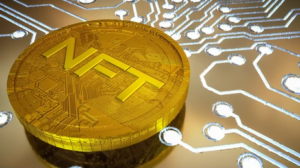- Introduction
The concept of Non-fungible tokens (NFTs) started when Kevin McCoy minted the first NFT viz. “Quantum” on May 3, 2014 which was sold for $1.47 million in 2021. A detailed article on the history of NFTs is covered here.
With the rising hype around NFTs, the questions as to what exactly is an NFT as well as issues regarding the intellectual property ownerships are major talks of the hour. Further, with the ease of creation of NFTs owing to the NFT platforms, every second person either wants to make and sell an NFT or purchase an NFT. This article aims to simplify the concept of NFTs as well as analyse its development and position in respect of intellectual property rights.
2. What is an NFT?
Non-fungible tokens (“NFTs”) are a type of cryptocurrency which is unique to itself and is irreplaceable. They have unique identification codes and metadata that distinguishes them from each other. For example, we can replace one INR 100/- note with ten INR 10/- notes, or five INR 20/- notes, or two INR 50/- notes, or one 50/- two 20/- and one 10/- note, thus making it replaceable or “fungible”. However, a painting drawn by Picasso can’t be replaced by a painting by Joan Mitchelle because these are unique works and therefore cannot be replaced. This concept of uniqueness linked to the NFTs is the biggest reason why it is so closely attached with the intellectual property (IP) laws.
3. How are NFTs created?
All the NFT platforms such as OpenSea, blockparty, etc. provide options to create NFT. The basic requirement for creating an NFT is to have an Ethereum wallet which needs to be connected with the profile on the particular platform. Thereafter, a gas fees which is the fees required to validate the transaction is to be paid for proceeding with minting of work on the token. Once the minting is successful, the NFTs are created and the same are available on the platform for sale. Such minting of work can in a way be compared to burning the CD. All the CDs prior to being burned are same, however become unique as soon as they are stored with information such as films, songs, presentations, etc. Though initially NFTs were created only on Ethereum, today several different tokes such as Polygon are used in creation of NFTs.
The ownership in an NFT is managed through a uniqueID and metadata that no other token can replicate [1]. Further, though NFTs are conceptually unique, it depends upon the creator of NFT on whether he wants to create one unique NFT or bulk NFTs on same art [2].
4. Purchasing NFT by execution of smart contracts
The purchase and sale of NFT becomes a binding transaction by execution of smart contracts. Smart contracts are digital contracts that are written by using codes and are stored in the blockchain. These are automatically executed when the action corresponding to such contract are done, such as, when a purchase of NFT is made. These smart contracts govern the relationship in respect of the rights transferred and/or provided to the buyer of the NFT. These may contain details including the details of owner, any restrictions on use of NFT, ownership of IP, governance of royalties as and when the NFT exploited/ re-sold, etc.
The image below represents the details section of an NFT available for sale on the NFT platform OpenSea. This details section provides link to the smart contract, the unique token ID number, as well as the type of blockchain on which the NFT is minted.

Image source: https://opensea.io/
5. NFTs and IPR
It is essential to understand that NFT is different from the work minted on the NFT. The IP is not on the NFT, but is on the work that is minted on the token that make this token non-fungible, hence becoming an NFT. Therefore, mere transfer on NFT does not qualify as a transfer of IP. The IP on the work that is minted on NFT is governed by the terms and conditions in respect of the IP provided in the smart contracts. For example, NFTs purchased on the platform ‘Royal’ provide the purchasers some percentage of royalty ownership in the songs which is specified in the smart contract.
For the NFT involving creative work, for example a song, digital art, etc., the work has a copyright. The terms and conditions of the NFTs would define whether it is a mere purchase of NFT without any rights in respect of the copyright being transferred, or whether it is a transfer providing certain rights in the copyrights or exploitation rights. It is also observed that many of such smart contracts reserve some royalty right for situations when the NFTs are resold. For example, the creator of NFT gets 10% of the sale amount as royalty every time the NFT is resold. Further, moral rights of the creator of the work also remain intact with the creator of the copyrighted work even after transfer of the NFT.
It is essential to note that copyright is a bundle of rights and exploitation in form of NFTs is only one such right in these bundle of rights enjoyed by the owner of copyright. By purchasing an NFT, the purchaser gets a right in and to the token and not the right to exploit the copyright in the work minted on this token. Such purchase does not inherently grant the purchaser any ownership of the exclusive rights that a copyright holder has. This can be compared to purchasing of a DVD of a film. By purchasing this DVD the purchaser does not get right to exploit the copyright in the film. A DVD only gives right to view the film, display it in non-commercial use or re-sell the DVD.
Since NFT is a product that is being sold in the market, the same can be trademarked. Many names and logos of NFTs have been trademarked so as to protect the brand of the NFT.
6. NFTs impact on the entertainment industry
Though NFTs were initially limited to digital art, the scope of the use of NFT has expanded manifold. Now one can purchase lands in a virtual world, buy clothes for their gaming characters, and even purchase a pass to sports events such as the bulk selling of passes of Australian Open.
Even Bollywood celebrities have started creating and selling NFTs. Amitabh Bachchan has launched his NFTs containing poetry collections, autographed posters, etc. through an exclusive platform and it has been reported that his NFT collection has been sold for approximately Rs 7.18 crore. An exclusive Bollywood media NFT oriented platform named Bollycoin has been launched in partnership with actor Salman Khan for Bollywood related NFTs, though the NFTs available on the platforms currently are of film series “Dabbang”. Viacom18 has also lunched its NFT platform named Fully Faltu. Sonu Nigam has also released his English single through his NFT series.
The rising NFTs in entertainment sector may raise issue on who has right to create an NFT- the producer, actor or artist. My understanding is that though the type and manner of selling of the product/ services may have changed due to digital money, the basic concepts of IP still remain well intact. When a character from the film or an exclusive video clip from the film is minted on NFT, the right to mint and sell such NFT will remain with the producer as he is the owner of copyright in the film, unless there is a contract to the contrary. Therefore, creating and selling NFT is one right of the bundle of rights provided in the copyright.
Considering the development of interest in NFTs, the day where premier to films will be done online in a meta plex (metaverse + multiplex), if we may say so, is not long. The tickets to such premier may be sold as NFTs similar to the Australian Open NFTs.
7. Theft and Fraudulent NFTs
NFTs are very simple and easy to create, and as the platforms offer free creation of NFTs, there has been a massive increase of fraudulent NFTs. Since minting of same work can be done on multiple blockchains and there is lack of mechanism to regulate and detect such multiple creations of NFTs for same work, it has become very easy to copy a particular work and create an NFT of someone else’s work. Further, with the increasing hype around bitcoin, NFTs and meta verse, several NFT platforms are being launched on daily basis but there is a major lack of adequate safeguard measures against theft of NFTs, sale of fraudulent NFTs, etc. It has been observed that due to such issue many platforms have started picking limited users who can create the NFTs and they do not allow every user to create NFTs on their platform. Further, many high-value transactions are now being conducted via offline contracts. This is so as to ensure the authenticity of both the buyer as well as the seller.
8. NFT platforms and intermediaries vis-à-vis the safe harbour provision
NFTs are digital products being sold on an online platform by the creator/ owner of NFT to a purchaser. Therefore, these platforms act as an intermediary, similar to that of Amazon. By such nature of the platform, it attracts Information Technology Act, 2000 (IT Act) as well as the Information Technology (Intermediary Guidelines and Digital Media Ethics Code) Rules, 2021.
However, unlike Amazon or other such intermediary platforms, the digital product that is being sold is created only due to such creation options and technique provided by these platforms. Therefore, creation of fraudulent NFTs or creating an NFT from a copied/ stolen work is essentially possible due to the creation options available these platforms. Thus, analysing whether these intermediaries are active intermediaries or a passive intermediaries play an important role in understanding whether safe harbour provision is applicable on these NFT platforms or whether the liability of IP infringement will also fall on these platforms.
9. Conclusion:
NFT as a whole is a combination of digital products (owing due to the work minted on the token) and investment (as it is a crypto currency). This along with the sudden boom around NFTs has increased the prices of something as simple as a single digitally created monkey image reach skyrockets. Though such new developments are welcoming, such sudden boom has led to several instances of IP infringement. Further, opting for dispute resolution mechanisms is also a challenge in NFTs mainly due to lack to laws governing them as well as due to the heavy international transactions involved in the NFTs due to the ease of conducting international transactions in digital assets. Though the concepts and application of IP remains same and only the mode of exploitation has changed, explaining the technicalities of NFTs in the courts of law will definitely be another challenge faced while enforcing IP rights in NFTs.
FOOTNOTES:
[2] https://blockparty.co/edition?id=392 – A bulk edition of NFT.
Image source: here
















